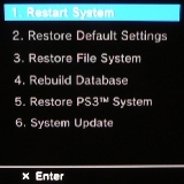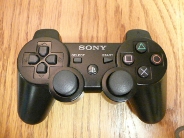General XMB Management
The XMB "Cross Media Bar" displays data vertically in a large, open directory. It can display subfolders generally to a single depth. In layman's terms, most sections of the media bar, particularly Music, Pictures, and Music, will display all the files under them and one tier of folders, and no further. This is explained in greater detail in the Movies, Music, and Video section.
APPEARANCE
Most functions of XMB customization are accessible simply through the Settings column. Many individual aspects can be adjusted by highlighting the item in question and pressing TRIANGLE to view its related options.
Example: By default with newest firmware updates, there is generally a scrolling PSN news ticker in the upper-right corner along with date/time information. The 'Information Board,' as it is called, can be disabled under the PSN column by pressing TRIANGLE on the Information Board icon.
The overall appearance is changed by XMB Themes, which can be downloaded from the PSN Store or an external drive and set via the Settings column. More information is available in our Themes section.
ORGANIZING CONTENT ON THE PS3 HARD DRIVE
Compatible files that have been downloaded or copied to the PS3 itself are essentially stored in one enormous directory for that type of file. By default, when you look under the 'MUSIC' column you will simply see a full list of all music files on the internal hard drive. The same display is default for video, picture, and game content. You can change the arrangement of the files by pressing SQUARE while viewing that column.
Some columns, particularly the Music column, have many different criteria that can be sorted with the SQUARE button. All of them at least have an option to display items by 'album.'
Using 'Album' tags is the best way to organize files on your PS3 without putting them on an external drive and changing directories with a computer.
All files, even Video and downloaded games can be assigned to an 'album.' Simply pick a file (or even a Game) on the hard drive and press TRIANGLE, then select 'Properties.' All files give you the option of changing the 'Album' setting under that file's properties. Once assigned an album, you can press SQUARE to change the view to 'Album' and see all files with that tag assigned to a folder under that name.
This can be incredibly useful for managing downloaded PSN games, especially once you have a large variety of different formats filling up your Game column. A convenient example is assigning all downloaded PS1 games to a 'PS1 Games' album, making a 'Demos' album, and etc. It will reduce clutter and make particular titles easier to locate.
Similar examples for the other XMB columns can be found on their respective pages of this site.
DISPLAYING CONTENT ON EXTERNAL DRIVES / DIRECTORY NESTING
On the three 'media' columns of the XMB along with the Game column, any connected external drives or inserted data discs will appear. What directories the XMB displays depends on which column you are looking in. For example, if you connect a USB thumbdrive and select it under the Music column, it will immediately open up the 'Music' directory on that thumbdrive. If there is no directory labeled 'Music,' it will say nothing is found. If the directory is empty if will say the same. If the directory has subfolders within it, it will display those folders and allow you to open them and any files in them. It will not display any subfolders past that level.
So, for example, a thumbdrive with the following contents would show up as empty when viewed under the Music (or any) column.
THUMBDRIVE ROOT:\ Song1.mp3
Song2.mp3
Song3.mp3
The PS3 will not see any of those tracks when opened under the Music column because it automatically looks for a directory labeled “Music.” If those tracks were in a “Music” directory as below, the PS3 would display them.
THUMBDRIVE
ROOT:\ MUSIC
\ Song1.mp3
Song2.mp3
Song3.mp3
To go one step further, the PS3 will also recognize subfolders within the Music folder.
THUMBDRIVE
ROOT:\ MUSIC \ Song1.mp3
ALBUM \
Song2.mp3
Song3.mp3
Any folders within that first subfolder will not be displayed. The Video and Pictures columns work identically, except searching for a “VIDEO” or “PICTURE” folder on the external drive rather than “MUSIC.” The same rules for directory depth/nesting apply.
VIEWING ALL NESTED DIRECTORIES WITH 'DISPLAY ALL'
This means that external drives (such as USB Hard Drives or thumbdrives) should have their files and folders arrange particularly for the PS3 if you wish to use them on a regular basis.
You still have the option to view all directories within a drive freely by choosing 'display all.' To use this option, scroll to the icon of the drive in question and press TRIANGLE. From there you can choose 'Display All' and go through directories freely to a depth of eight nested subfolders. It will only display files themselves if they are playable under that column. For example, if you go under the VIDEO column and highlight a thumbdrive, press TRIANGLE, and select 'Display All,' it would show all folders, but only files that are a video format the PS3 can display.
THUMBDRIVE ROOT:\ FOLDER1
\ Video1.avi
FOLDER 2 \ Video2.avi
FOLDER 3 \ Video3.avi
Using Display All frees you from looking only in PS3-specific labeled “VIDEO” directories or being limited to only one depth of subfolder. It will not, however, display any incompatible files. If there were any MP3 audio files in those directories, for example, they would not be visible when searching under the Video or Picture columns.






